thebestschools.org is an advertising-supported site. Featured or trusted partner programs and all school search, finder, or match results are for schools that compensate us. This compensation does not influence our school rankings, resource guides, or other editorially-independent information published on this site.
Are you ready to discover your college program?
Quick, when you think of amazing buildings, what image comes to mind? Is it anything like one of the 25 Most Amazing Campus Buildings assembled here? We are betting that at least a few of our Top 25 entries matched your mental picture.
Our collection of impressive buildings, though, has one major difference you may not have thought of: the grandiosity of these structures is justified. Their excesses, even when they involve hundreds of millions of dollars, are necessary and well worth it!
To qualify as an amazing campus building, we settled on four categories or criteria: (1) cost; (2) size (including the size or rarity of the collections housed in the building or complex); (3) architectural elements, including the fame of the architect, the style or importance of the architecture, or the materials and decorations used; and (4) amenities and innovative features.
Students evaluate a college or university based on many factors that go far beyond the strength of faculty or programs offered. Are you interested in studying music or drama? A school that has a highly visible and acoustically superb space dedicated to the performing arts will almost certainly make the top of your list.
Many students are able to attend top tier universities because of sports scholarships. Doesn’t it make sense, then, that a school would offer these students state-of-the-art training facilities and magnificent stadiums that can accommodate tens of thousands of fans in style?
The amazing campus buildings and structures that follow enhance student life and the college experience as a whole.
The 25 Most Amazing College Campus Buildings
1. Texas A & M University-College Station (TAMU), Kyle Field
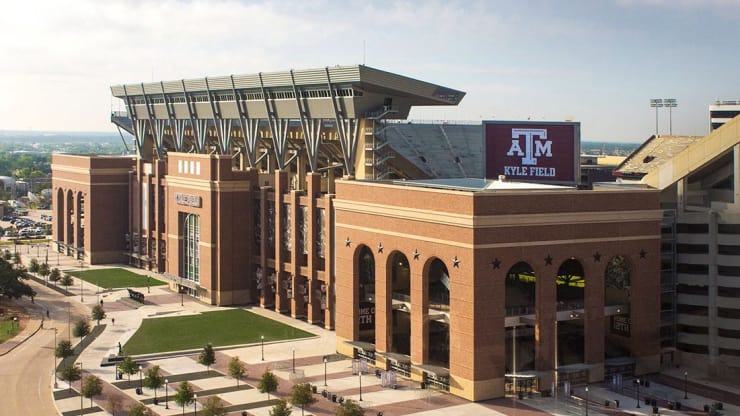
The most expensive and amazing building on our list may actually be the most necessary. Yes, Texas A&M University (TAMU) did spend almost $485 million in 2015 to get a bigger football stadium than their state and conference (SEC) rivals. However, the renovations to Kyle Field (the stadium that Johnny Manziel/ Johnny Football built) are much more than just a chest-thumping exercise. In addition to a better fan experience (did we mention double the number of women’s restrooms?) and increased seating capacity to capitalize on surging attendance, the increased noise levels at the Hate Barn ensure a more intimidating place for opposing teams.
Securing the Aggies’ future success is vital, because its most recent triumphs have finally allowed it to financially supplement TAMU’s other sports teams---so the university no longer has to. In fact, the athletics department is now doing well enough to contribute to, and raise money for, the university, all because of the football team. And, hey, it’s not like they spent the $485 million on the arts or something.
2. Yale University, Stephen A. Schwarzman Center

Spending hundreds of millions of dollars on the arts is exactly what Yale is planning to do, which has generated both anger and praise. In fact, when Yale announced that Stephen A. Schwarzman, controversial head of the Blackstone Group, was making a $150-million donation for a third arts center, some immediately questioned it as an amazing ego project. Others, however, realized the new Schwarzman Center would address two vital needs.
First, it will be a central student hub---something which the students have been asking for. Second, it will be an arts, cultural, and events center that furthers Yale as a tourist attraction. This will bring additional visitors to its other iconic buildings (including Durfee Hall, where Rory Gilmore and Paris Geller lived during the fourth season of the Gilmore Girls) and thereby help the struggling city of New Haven, which depends heavily on Yale as an attraction and employer.
3. The New School, University Center
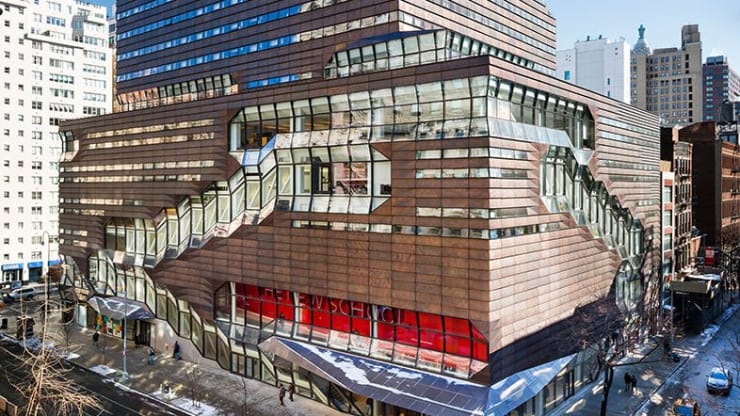
While New York City and Manhattan will likely never depend on one building or employer, it does have something in common with a small city like New Haven. This expensive metropolis does get upset when it doesn’t like the plans for an amazing new building. That was the case when The New School---a private, non-profit research university whose trustees and leaders have had ties to some of the biggest names in American politics (incl. Hillary Clinton, Barack Obama, and John McCain)---proposed its new University Center. In fact, the proposal not only angered area residents, it even formed part of student protests.
Thankfully, The New School listened and adjusted its plans. The result is a 375,000-square-foot, LEED-Gold-certified, active-design University Center that encompasses classrooms, a faculty resource center, a library, student housing, an auditorium, student lounges, dining areas, retail space, and more. When you realize that it’s almost an entire campus in one building, in an expensive area of NYC, and then Mayor Michael Bloomberg lauded it as an example for local architects, it becomes clear just how reasonable and justifiable this extravagance is.
4. University of Michigan-Ann Arbor, Michigan Stadium
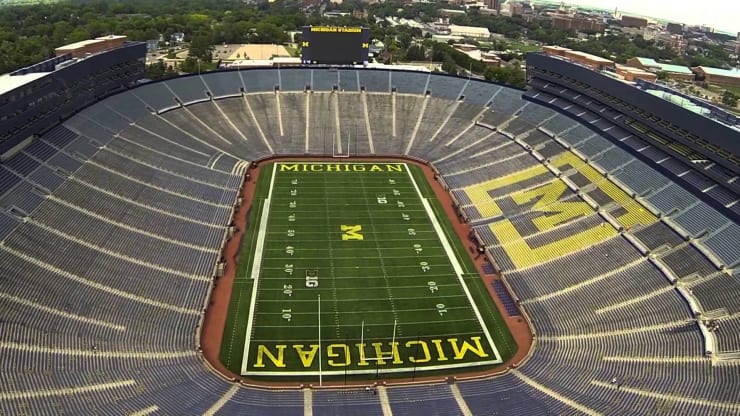
Another large-scale project that generated much controversy was the $226-million renovation of the University of Michigan’s (U-M’s) Michigan Stadium. In fact, complaints, petitions, a lawsuit by paralyzed veterans, and a letter from the Department of Education threatening funding cuts all greeted U-M’s initial plans.
Thankfully, things were eventually resolved and the renovation was completed in 2011 with much-needed upgrades and a few luxury touches that have helped secure the stadium’s longer-term future and helped it garner a number of national events. While it may still seem like an unnecessary extravagance to some, consider that U-M’s athletic department regularly ranks in the Top 5 nationally for annual revenues, with the majority of that coming from its highly profitable football program. In other words, without the ongoing success of the football Wolverines, the athletics department would cost the university a lot of money. (This is also why U-M spent some $40 million to pry Jim Harbaugh away from the NFL.)
5. California State University---Northridge, Valley Performing Arts Center
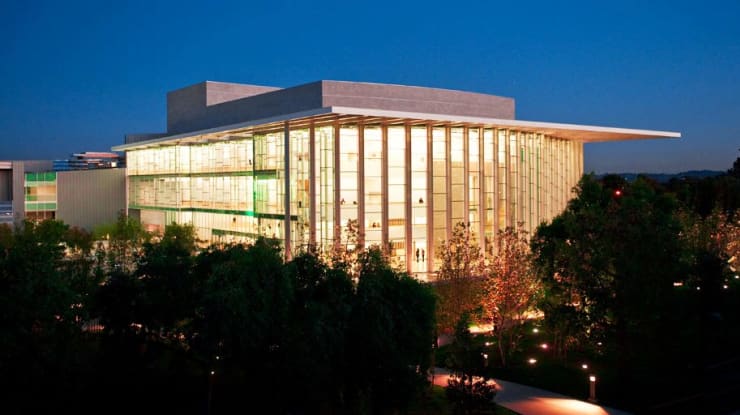
It may seem like amazing college football stadiums are all in the Heartland, while the lavish arts centers dot the East and West coasts, but this is not always the case... well, after this entry it is not the case.
Completed in 2011 at a cost of $125 million, the state-of-the-art, LEED-Gold-certified, 166,000-square-foot Valley Performing Arts Center (VPAC) at California State University-Northridge (CSUN) is the centerpiece of the university and cultural hub of the San Fernando Valley. Built at the height of the recession, VPAC had been in planning for a decade prior---the region needed an arts facility and CSUN wanted to further its connection to the community. Unlike projects at some other universities, this one had both public support and community funding. People in the Valley recognize CSUN’s key economic role and knew creating a world-class facility would draw major attention (opening night performers and attendees included Harrison Ford, Calista Flockhart, Andy Garcia, and Beau Bridges).
6. University of Wisconsin-Madison, Union South
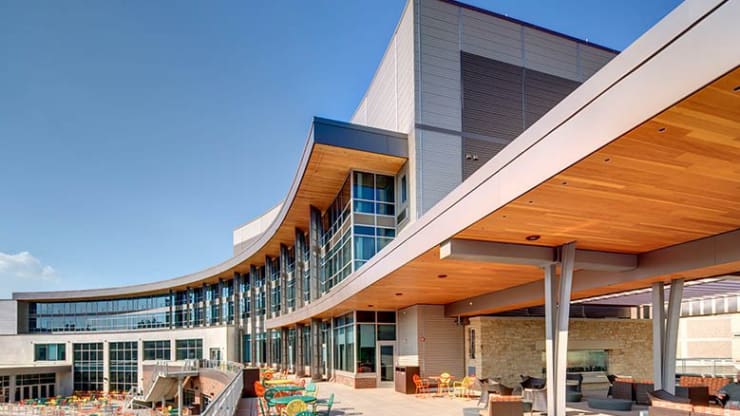
While football stadiums and arts centers are great for bringing in revenue and connecting with the larger community, the interests and opinions of students are not always front and center. One building where they are is a student union. However, that doesn’t mean those structures aren’t without controversy, especially when one of them costs almost $95 million (2011 dollars) to build.
Created with the input of some 36,000 students, Union South at the University of Wisconsin-Madison (UW) is a Frank Lloyd Wright-inspired, 277,000-square-foot, LEED-Gold-certified student union with an art gallery, bowling alley, climbing wall, billiard hall, movie theater, restaurants, hotel, and banquet hall. It has drawn praise from many, but also criticism from some for its seeming financial extravagance---usually by those who don’t realize student fees pay for much of the construction costs over time. However, even if student fees and revenues were not behind Union South, the simple truth is the battle to attract and keep students is raging, so a few conveniences are no longer a luxury.
7. Princeton University, Nassau Hall
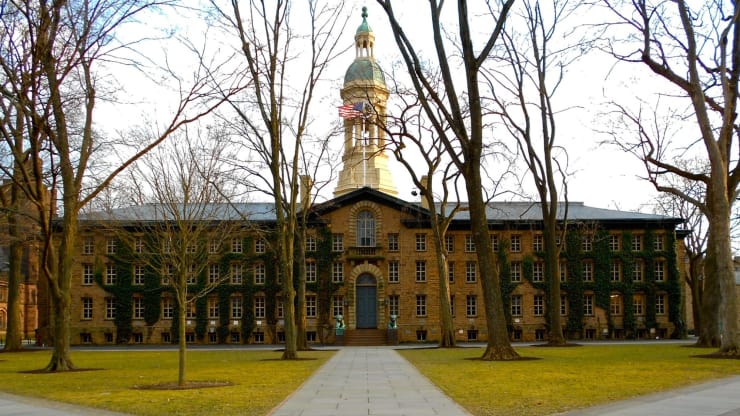
Princeton University’s Nassau Hall has seen many battles, as well, just of a wholly different kind. In fact, Nassau’s presence on this list raises a key question: Can a building that’s been at the heart of the American Revolution and Continental Congress (however briefly), and the spot where Gen. George Washington resigned as head of the Continental Army, really be considered amazing?
Well, when it was completed in 1756, its extravagance centered on its sheer size---it was alternately known as the largest building in New Jersey, the largest academic building in the American colonies, and the largest stone structure in North America. However, after surviving for 260 years, through wars and fires, it is now known for a lot more than its size. Nassau is the stalwart, resolute, enduring symbol of one of the country’s top-ranked universities (and sometimes it even exemplifies America’s own spirit).
8. Duke University, Duke University Chapel
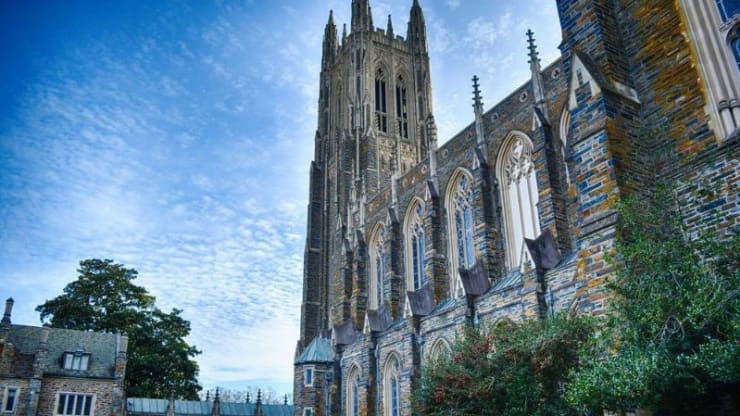
Equally impressive in size, but far more ornate in detail and the decorative materials used, the Duke University Chapel screams extravagance from every corner. From its 210-foot bell tower---which makes it still one of the tallest buildings in Durham County, N.C.---to its ornate and decorative Collegiate Gothic architecture, three massive pipe organs, and 77 stained glass windows (which utilize over one million pieces of glass), its a wonder of design, faith, and craftsmanship.
Designed by well-known African-American architect Julian Francis Abele, and completed during the height of the Depression, the Chapel was the crowning glory for Duke’s then new West Campus and reflected this private, non-profit research university’s deep ties to the Methodist Church and Duke family. Amazing, yes, but it’s hard to not be at least a little impressed by this magnificent structure, and to feel a little swell of pride if you are a Blue Devil alumnus.
9. Stanford University, Hoover Tower
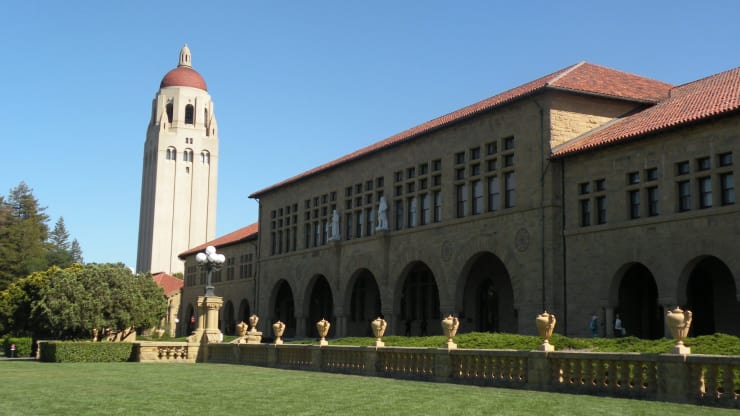
When it comes to towers, size certainly matters. On the West Coast, one of the most amazing college towers you’ll find is Hoover Tower at Stanford University. At 285 feet tall, this impressive structure literally towers over everything else around it, providing orientation for those walking through the campus and a magnificent view for anyone standing on its observation deck. However, this minimalist Art Deco building is much more than just an impressive and iconic structure.
Designed to celebrate the university’s 50th anniversary (although some reports say various university officials initially opposed it), the tower’s main purpose was to provide the space needed to house the extensive War, Revolution, and Peace library of President Herbert Hoover (a Stanford alumnus). Appropriately, in the 1970s, activist and Nobel-Prize-winning writer Aleksandr Solzhenitsyn secretly lived on the 11th floor during his exile from the Soviet Union.
10. Oklahoma State University, Student Union
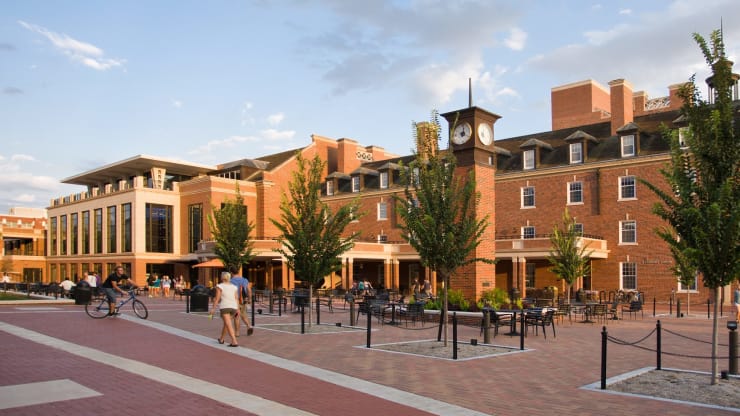
While not as historically significant as the Duke Chapel, Nassau Hall, or Hoover Tower, the Student Union at Oklahoma State University (OSU) may top them all when it comes to amazing size. Coming in at 611,000 square feet, it is the largest and most comprehensive student union in the world. It has almost everything a student could need or want, including: a 550-seat movie theatre, wine bar, hotel, food courts (which provide tens of thousands of free late-night pancakes during finals), tons of Wi-Fi hotspots, student lounges, study areas, a bank, post office and copying center, and the University Store. Plus, its 2012 renovation brought it up LEED Silver status, the first building on campus to achieve this.
Lest anyone think this extravagance came at taxpayer expense, rest assured it did not. Throughout its history, student fees and revenue from operations have provided all or most of the funding for the Student Union’s construction, renovations, and ongoing costs. So, in that way, maybe it does have a lot of historical importance.
Popular Online Programs
Learn about start dates, transferring credits, availability of financial aid, and more by contacting the universities below.
11. Vassar College, Thompson Memorial Library
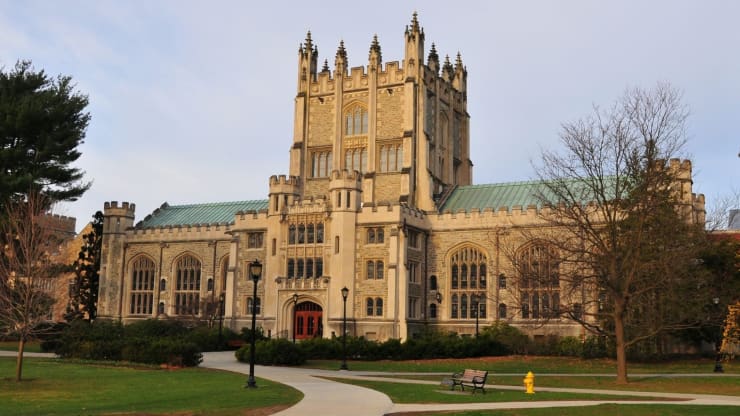
Of course, there is historical importance and then there is historical importance. As one would expect for a building at the elite Vassar College, the Thompson Memorial Library is extravagance and history personified. Its impressive and important architecture features all kinds of grand details and decorations---including an incredible stained-glass window depicting Lady Elena Lucretia Cornaro-Piscopia becoming the first woman to receive a doctorate.
However, it is not the architecture that earns Thompson its spot on this list of amazing college buildings. It is the rarity and importance of its countless books and documents. For instance, the library houses various exclusive collections of papers and correspondence from such luminaries as Susan B. Anthony, John Burroughs, Elizabeth Cady Stanton, Samuel Clemens (Mark Twain), and Albert Einstein. It also has microtext collections of the FBI’s files on Martin Luther King, Jr. and President Lyndon Johnson’s Security Files on the Vietnam War. Among its rare books are more than three-dozen printed before 1500 (incunabula) and several leaves of the Gutenberg Bible.
12. Kennesaw State University, The Commons
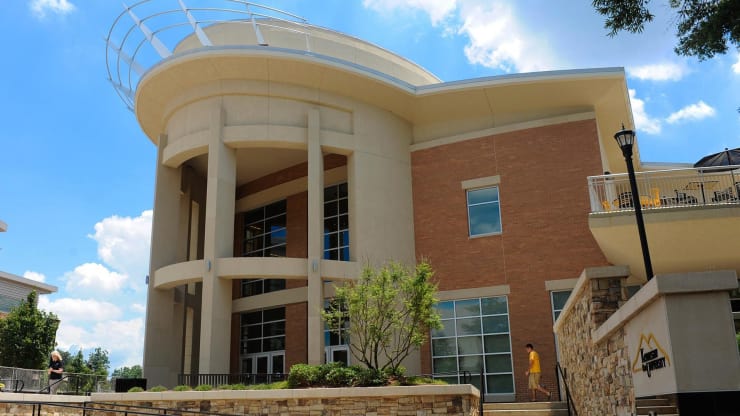
Of course, amazing buildings with historical importance must have a starting point and someone with a vision of what they could become. So, while Kennesaw State University (KSU) may not have the history of America’s Ivy League or Seven Sisters schools, it is looking toward the future and looking to leave its own mark on it.
That is what this public research university did when it created The Commons, a 54,000-square-foot dining hall. What is so historical or amazing about a dining hall? Did we mention it is one of the largest LEED-Gold-certified college dining halls in the U.S.? In addition to its impressive size and tiny environmental footprint is its overall focus: the health of its students and success of local businesses. Its modified farm-to-table (a.k.a. farm-to-campus) focus means most of the food and ingredients at The Commons are from local and campus farms. In addition, there are nutritional and wellness programs, an on-site herb garden, gluten-free and vegan food options, and ties to a community garden involving school kids and local residents.
13. University of Akron Main Campus, Student Recreation and Wellness Center
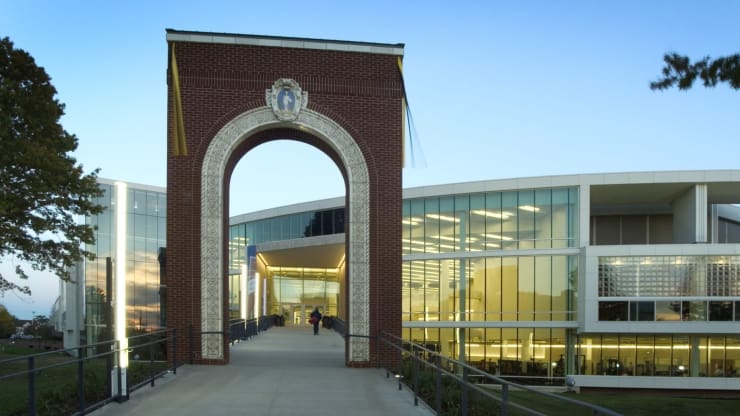
Like KSU, the University of Akron (UA) also focuses on student health. It even has a very amazing building dedicated to this focus.
Although, on its surface, UA’s Student Recreation and Wellness Center (SRWC) seems more like a playground than a necessity. Walking into this 295,000-square-foot structure with its leisure pool, lazy river, 30-person spa, workout center, exercise studios, five gyms, and 54-foot climbing wall, one may think they have entered a very large, fancy health club. They may also begin to wonder whether a public university really needs a building like this. However, when you realize that Ohio can have long, cold winters, severely limiting what many students can do to de-stress and stay physically and emotionally healthy, having a sizeable indoor activities center that can accommodate as many students as possible starts to make a great deal of sense.
14. Oberlin College, Conservatory of Music
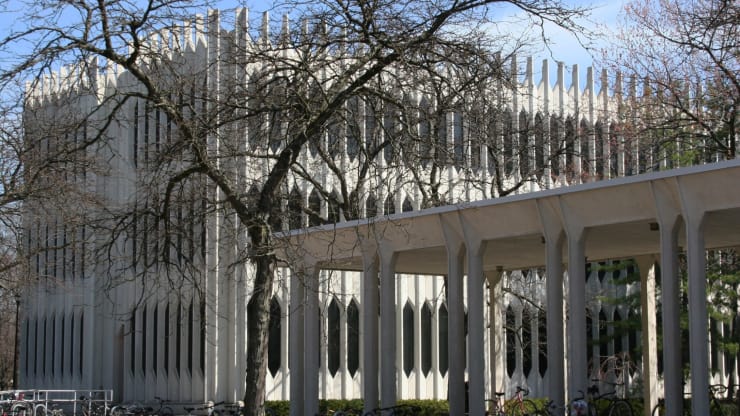
When it comes to amazing collections and spaces, the Oberlin College Conservatory of Music (the oldest continuously operating conservatory in the U.S.) may have everyone beaten. Housed within its four interconnected buildings---three of which were designed by the iconic architect Minoru Yamasaki, who also designed the World Trade Center---are over 1,500 concert-quality musical instruments, including 240 Steinway pianos and 17 organs; 150-plus practice rooms (most with windows); various performing areas, along with concert and recital halls; and two fully equipped audio recording rooms, all for the use of Oberlin’s music students. (This is to say nothing of its massive and impressive archival collections, including one with 100,000 jazz recordings.)
Given the number of award-winning musicians Oberlin has produced, it seems these extravagances are well worth it. The U.S. government probably thought so, too: President Barack Obama honored the conservatory with a 2009 National Medal of Arts to recognize its lifetime of contributions.
15. Bard College, Fisher Center for the Performing Arts
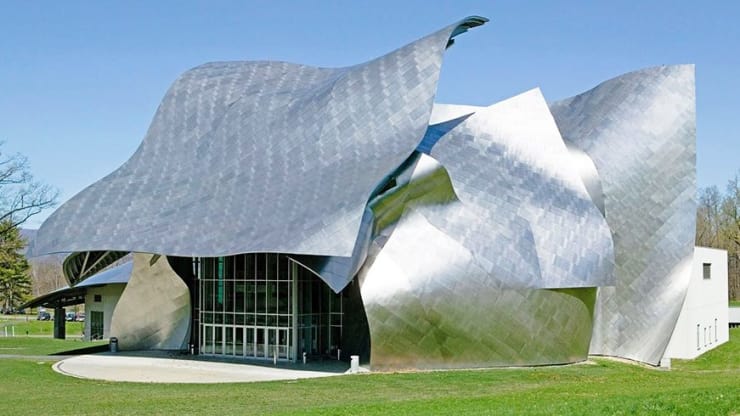
One of the most amazing performing spaces anywhere in the U.S. is the Fisher Center for the Performing Arts at Bard College. While it is pretty much a given that anything designed by the legendary Frank Gehry will be considered amazing, its level of extravagance is heightened when one realizes how small Bard is (it has only a little over 2,000 students at its main campus). Of course, if you are a small, private college with a strong focus on the arts, but also serve as a major cultural hub for your community and the larger region, is there a better way to further and promote both functions than to have an iconic, destination facility that audience members, students, and performers alike want to experience?
Like most Gehry creations, this $62-million (2003 dollars), geothermal-heated, 107,000-square-foot, acoustically tuned masterpiece has garnered some criticism, but tons more praise. It has also allowed Bard to further its focus on the arts, including creating a music conservatory. The design may not be for everyone, but it certainly has helped Bard and the local community.
16. University of California-San Diego, Geisel Library
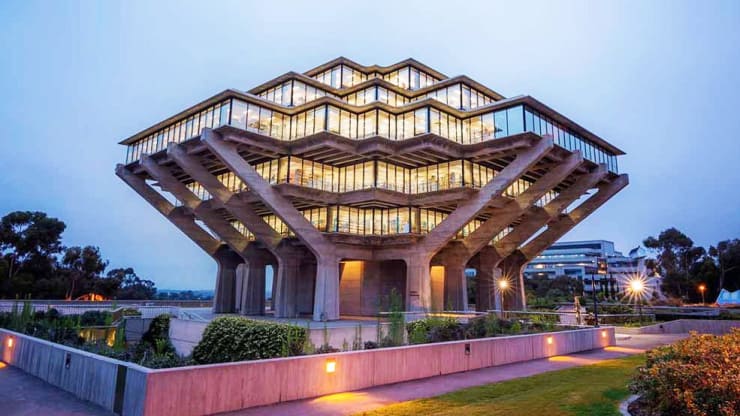
Some buildings are as iconic as a Frank Gehry design, but if they follow the Brutalist architectural style, they probably face an uphill battle for acceptance. While many lament the Brutalist era, especially on college campuses, a few buildings have stood the test of time and earned their place in pop culture. One of those is the William Pereira designed Geisel Library. Situated at the heart of the University of California, San Diego (UC San Diego), the library looks like some kind of futuristic tree house, or a hovering alien spaceship.
Completed in 1970 at a cost of $4.4 million, the Central Library quickly became equal parts mocked eyesore and cherished icon. The amazing strangeness of its creation may have reached its height in 1995 when it took on the names of Theodor Geisel (Dr. Seuss), and his wife Audrey. How can anyone mock a Seuss, he must he must, I say quite plainly this, be subject to witticism, criticism, and abuse.
17. University of Virginia-Main Campus, The Rotunda
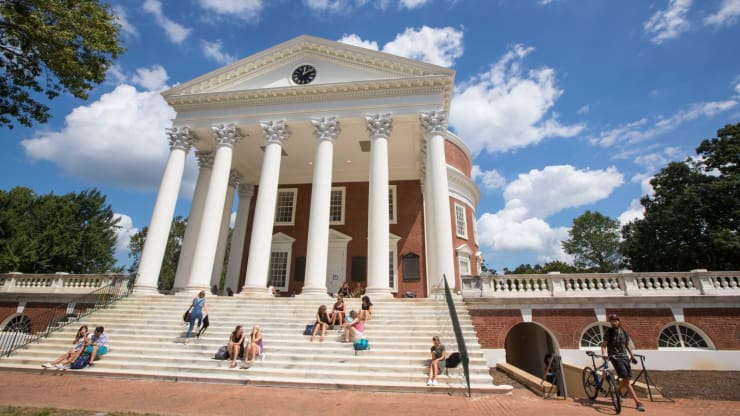
One building that is almost universally praised is The Rotunda at the University of Virginia (UVA). Designed by UVA’s founder, Thomas Jefferson, this architectural and academic centerpiece of the university highlighted Jefferson’s commitment to the separation of church and state, and to creating a university free of religious influence.
Ironically, this majestic, religion-free building honors the design of the Pantheon, a Roman temple (now a church). Although, maybe that was Jefferson’s little joke on everyone. No matter, The Rotunda has not only stood the test of time and changing tastes to inspire buildings on a host of other university campuses, its designation as a UNESCO World Heritage Site has confirmed its future and international significance.
18. Brown University, Granoff Center for the Creative Arts
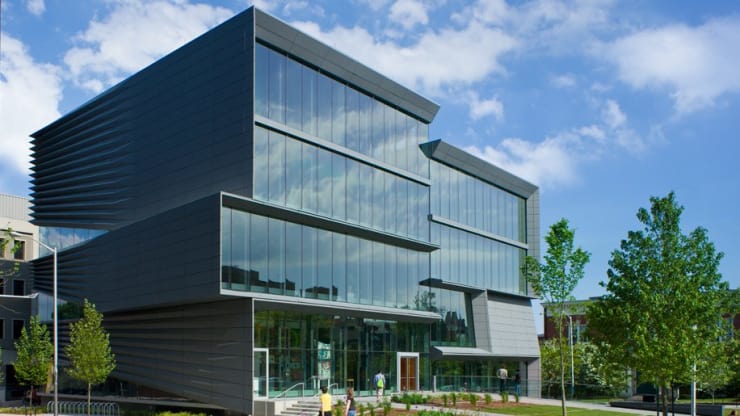
One building that aspires to the lofty heights of Jefferson’s Rotunda is the Granoff Center for the Creative Arts at Brown University. Like The Rotunda, Granoff’s extravagance lies in its architecture and purpose. Deconstructivist in style, the Center is both elegant and odd, depending on the angle from which it’s viewed. Being viewed, of course, is at the heart of its purpose, which is why it has floor-to-ceiling windows: to allow those outside to see in. It’s also why the side-by-side halves of the building are vertically offset, to allow different spaces on each floor on one side to see into two floors of rooms on the other.
The entire building is a place where arts, humanities, and sciences can interact and collaborate in new and unique ways. It is a grand and forward-thinking concept that required a grand design.
19. University of Missouri--St Louis, Touhill Performing Arts Center
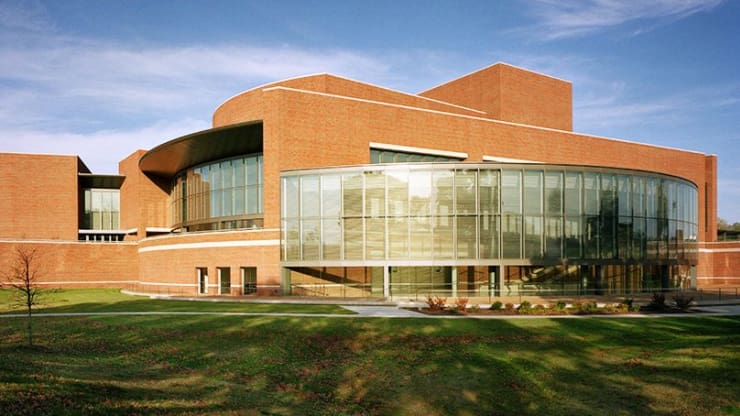
Breaking the mold of amazing performing arts theatres that seem to only be on America’s East or West coasts is the Touhill Performing Arts Center at the University of Missouri-St Louis (UMSL). Located in the middle of the Heartland, this understatedly amazing structure is the creation of Pei, Cobb, Freed and Partners. While some mistakenly attribute the design to the master I.M. Pei, he had already retired years before. It was in fact designed primarily by Henry N. Cobb, one of Pei’s original partners, and a noted, award-winning architect in his own right.
Touhill is a landmark structure for UMSL. It helps the university garner national recognition through its elegantly and impressively designed performance spaces, which maintain a high level of functional suitability and technological capability.
20. Emerson College, Cutler Majestic Theatre
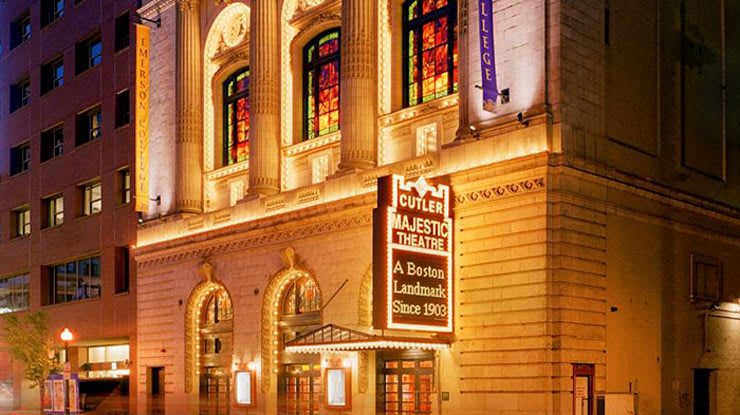
Located on a completely different point on the design spectrum to Touhill and Granoff is the Cutler Majestic Theatre at Emerson College. A throwback to a different era, the Majestic is probably the image many people have in their heads when they think of an amazing building. This Beaux Arts beauty, a John Galen Howard design, is one of the last of its kind in the U.S., and is listed on the National Register of Historic Places. Rescued and returned to its former glory over the course of a 20-year, $14.8-million restoration project that was completed in 2003, the Majestic takes visitors back in time to the last remnants of a gilded age when opulence and grandeur emanated from every detail---a time when this performing arts theater was the most beautiful in all of Boston.
While the Majestic is not something one would expect to see at such a small college as Emerson, given its exclusive focus on communication and the performing arts, it really does make sense that Emerson rescued this architectural and historical gem and integrated it back into the city’s arts community.
21. University of North Florida, Osprey Fountains

Under the more modern definition of amazing buildings, one would probably find pictures of the student housing complex known as Osprey Fountains. Built on the campus of the University of North Florida (UNF), this resort-like dormitory has amenities to spare. In fact, some have described it essentially as a resort. Why? Well, consider that some of its features/ amenities include: high-speed internet access and cable in every bedroom, a video game room, study library, karaoke and open-mic comedy lounge, sports and entertainment lounge with plasma TVs, laundry rooms on every floor, a fitness center, lap pool and lazy river, tennis courts, basketball courts, a putting green, and a running track. There is even a shuttle that stops directly in front of the complex to take students to class.
At a cost of $86 million (2009 dollars), the investment was not a small one, but it has given UNF an edge in the battle for new students.
22. University of Missouri-Columbia, Mizzou Aquatic Center
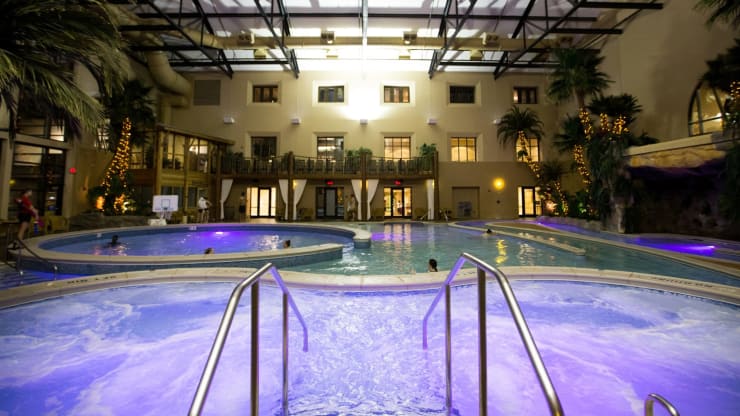
The University of Missouri-Columbia (Mizzou) also has an amazing building filled with relaxing amenities, but this one is available to all of the university’s students. The Mizzou Aquatic Center is not just one of the best aquatic facilities among post-secondary institutions, but anywhere in the country. With four pool complexes, there is something for every student, from the most competitive swimmer or diver, to the biggest beach bum.
The 50-meter competition pool and diving well are mainly for the athletes, but certain areas can allow anyone to indulge in their Olympic dreams. The Tiger Grotto is a year-round indoor beach (your very own Spring Break) with a lazy river, vortex generator, walk-in pool entry, waterfall, hot tub, sauna, and steam room. Finally, during the spring and summer months, there’s the outdoor Truman’s Pond beach club that allows for relaxing, sunbathing, and swimming. Designed to promote a healthy, active lifestyle, the Mizzou Aquatic Center is a great draw for students deciding on which school to attend.
23. University of Houston, Calhoun Lofts
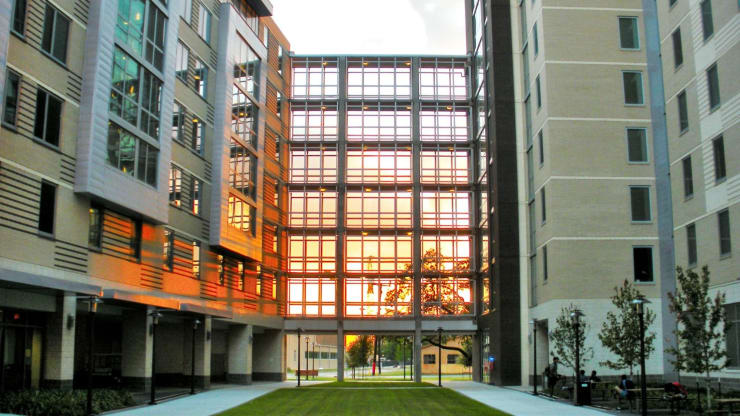
The University of Houston’s (UH’s) attempts to recruit and retain students have seen it dive into the world of amazing student housing options. Unlike the sparse, communal living arrangements Boomers and even Gen Xers likely suffered through, UH’s Calhoun Lofts have the privacy, features, and amenities Millennials and Gen Zs expect and desire. Each unit feels like an urban loft, with 10-foot ceilings, full-height windows, and exposed concrete floors and ceilings. Appliances are standard, as is Wi-Fi and cable. On-site features include two rooftop terraces, a sky lounge, fitness center, free laundry facilities, retail stores, courtyard, study areas, a movie theater, pool tables, and computer lab.
Although students must be juniors or over 21 to live here, and it cost UH almost $108 million to complete in 2009, Calhoun has helped UH begin to shed its image as a commuter school. Getting students to live on campus means they are more integrated and involved, which has benefits in terms of student success, retention, and graduation (never mind the potential for increased revenues and donations that increased student success brings).
24. University of Chicago, Mansueto Library
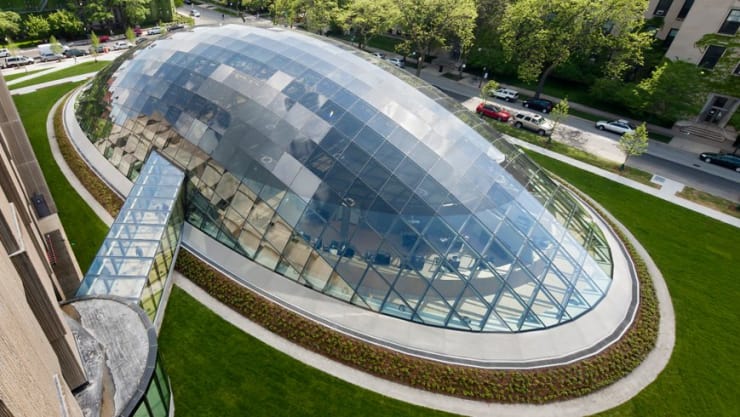
If you are a technology geek, the University of Chicago’s (U of C’s) newest library may be the place for you. After all, how many libraries can you walk into that are served by robots? Well robotic cranes within the automated storage and retrieval system (ASRS), more precisely. This unique technology means when you go online to request a rare book, it will normally arrive in your hands, in the glass-domed reading room of the Mansueto Library, inside of three minutes.
While some may say this award-winning and eye-catching library (designed by Helmut Jahn, one of America’s top architects) is an unnecessary extravagance, pretty much everything about the design is vital and groundbreaking. That includes the space-saving, climate-controlled underground storage of the library’s 3.5 million volumes, many of which are rare and have special preservation and storage requirements. And, hey, a wealthy billionaire did kick in about a third of the money needed to build it.
25. North Carolina State University at Raleigh, Hunt Library

If knowledge is still at the heart of colleges and universities, it seems fitting we end this list with a building that looks to the future of what libraries can be: the Hunt Library at North Carolina State University (NCSU). This future is founded on Hunt’s modern design and fabulous technologies and features, including: the BookBot automated storage and retrieval system; a makerspace; game lab; teaching and visualization lab; immersion theater; research commons; multimedia tools for audio and video recording; 3-D printers and scanners; and a laser cutter. All of that, in turn, supports and facilitates the library’s focus on being a center for the kind of collaboration and innovative thinking that helps foster tomorrow’s designers, engineers, humanists, researchers, and scientists.
Completed in 2013 at a cost of about $115 million, this research library could be as revolutionary as what Thomas Jefferson intended with the University of Virginia---the foundation of a new and freer way of thinking, learning, and working together for a brighter future.
Popular with our students.
Highly informative resources to keep your education journey on track.
Take the next step toward your future with online learning.
Discover schools with the programs and courses you’re interested in, and start learning today.

